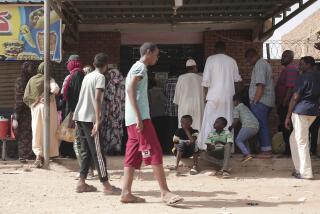Peru Is Facing a Lengthy Cholera Battle : Health care: Although the epidemic has subsided, the disease is going to be endemic, officials say.
- Share via
LIMA, Peru — This nation’s worst fear about cholera now appears certain to materialize: The disease, which has killed at least 2,390 people here since it broke out in late January, will plague Peruvians for years.
“It is going to be endemic,” said Dr. Carlos Moreno, who helps direct the Health Ministry’s anti-cholera efforts.
The only other countries where the disease is endemic are in Asia and Africa.
The Peruvian cholera epidemic is the first since early this century in the Western Hemisphere, and it has been one of the most severe on record anywhere. The good news is that Peru’s fatality rate is among the lowest ever for a cholera epidemic--about 1% of reported cases.
The epidemic has subsided in recent months in areas where most of Peru’s people live, along the Pacific coast and in the Andean highlands. The Southern Hemisphere winter has brought lower temperatures that inhibit the propagation of cholera bacteria.
But in the tropical lowlands of eastern Peru, the epidemic continues. And Moreno predicted increased cholera in Lima and other coastal areas when summer returns.
“There will be a resurgence, definitely,” he said in an interview. “We are preparing so that the magnitude will be much less than what we had this year.”
Moreno and other experts agree that it will take years and hundreds of millions of dollars in public health and sanitation projects to eliminate cholera. The disease, which causes severe diarrhea that can lead to dehydration and death, spreads by contamination of food and water with infected human waste.
Of neighboring South American countries where cholera has spread from Peru, the hardest hit has been Ecuador, with more than 26,000 cases and at least 375 deaths reported.
In Peru, a report issued by the Health Ministry this month said that 240,076 cases had been detected here. More than 92,000 cholera patients have been hospitalized.
At the epidemic’s peak in the Lima area, about 600 people a day were being hospitalized. Now, hospitals are receiving 20 to 30 cholera patients a day, Moreno said.
He said the Lima mortality rate has been held to 0.39% through effective treatment at hospitals and public clinics and through the work of neighborhood committees, which have been formed to chlorinate drinking water, distribute packets of rehydration salts and spread information on hygienic measures for preventing cholera.
In remote, rural areas of Peru that lack health and sanitary facilities, death rates have sometimes reached more than 5%. Moreno said government anti-cholera measures in the eastern lowlands have reduced the mortality rate there to 1.5% from 5%.
Dr. Uriel Garcia, a former Peruvian health minister, said doctors have worked effectively to control mortality rates. But he gave the government little credit for reducing the epidemic’s intensity.
“It has gone by itself, absolutely by itself,” he said. The government took no measures to supply Lima slums with emergency sources of clean drinking water, he said, and feeble government educational efforts accomplished nothing.
To protect Peruvians from endemic cholera, he said, the government will have to build water and sewage networks worth an estimated $2 billion, a cost that Peru cannot meet without foreign aid. Until that is done, recurrent surges of cholera will be inevitable, he predicted.
More to Read
Sign up for Essential California
The most important California stories and recommendations in your inbox every morning.
You may occasionally receive promotional content from the Los Angeles Times.













